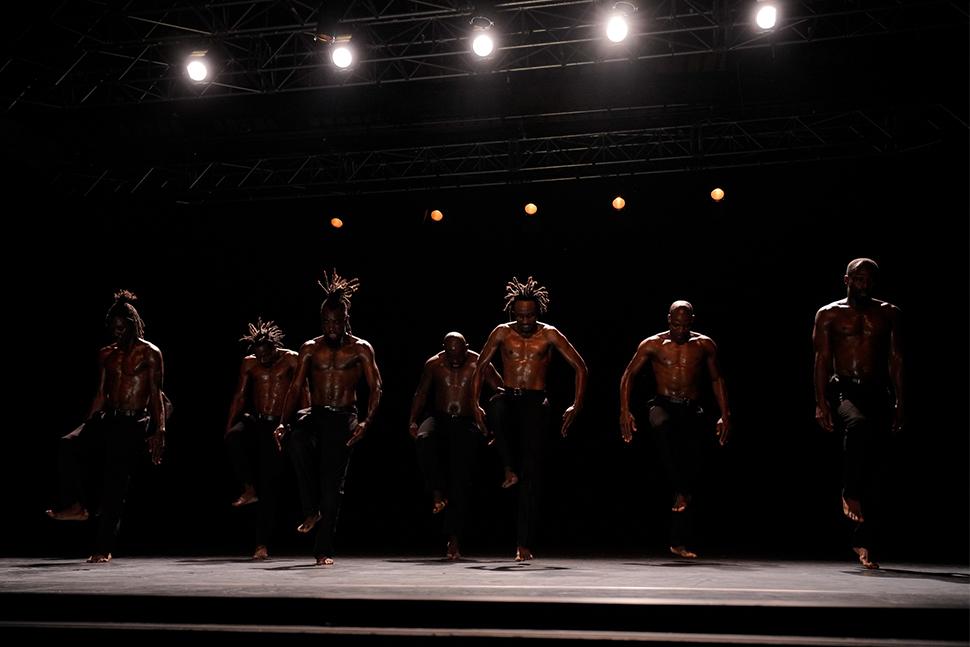| Year / Length: | 2021, 55’ (Italian premiere) |
|---|---|
| Choreography: | Josef Nadj |
| With: | Djino Alolo Sabin, Timothé Ballo, Abdel Kader Diop, Aïpeur Foundou, Bi Jean Ronsard Irié, Jean-Paul Mehansio, Marius Sawadogo, Boukson Séré |
| Artistic collaboration: | Ivan Fatjo |
| Light design: | Rémi Nicolas |
| Soundtrack: | Tatsu Aoki & Malachi Favors Maghostut, Peter Brötzmann & Han Bennink, Eureka Brass Band, Jigsaw, Lucas Niggli, Peter Vogel |
| Technical director: | Sylvain Blocquaux |
| Sound engineer: | Ivan Fatjo |
| Production and tour: | Bureau PLATÔ – Séverine Péan, Emilia Petrakis |
| Executive producer: | Atelier 3+1 |
| Co- production: | Les Nuits de Fourvière, festival international de la Métropole de Lyon; Les Théâtres de la Ville de Luxembourg; Le Trident – Scène nationale de Cherbourg-en-Cotentin; MC93 – maison de la culture de Seine-Saint-Denis; La Comédie de Valence, Centre dramatique national Drôme-Ardèche; Charleroi danse, Centre Chorégraphique de la Fédération Wallonie-Bruxelles; Le Grand Angle – Scène régionale Pays Voironnais; Théâtre des Salins, scène nationale de Martigues; Centre Chorégraphique National de Tours / Thomas Lebrun (Accueil-studio); Théâtre des Quatre Saisons – Scène Conventionnée d’Intérêt National «Art et Création» |
| With the support of: | Ministère de la Culture – Direction régionale des affaires culturelles d’Ile-de France, Région Ile-de-France, Institut français & programme Teatroskop | Angers – Centre National de Danse Contemporaine, CND – Centre national de la danse, La Briqueterie CDCN du Val-de-Marne, Scène Nationale d’Orléans |
Josef Nadj - Omma

Description
There are eight of them, in jackets and black trousers, a nod to Josef Nadj’s timeless silhouette. In lending them his costume, he commits each dancer not to walk in his footsteps, but to reveal his own singularity. Above all, OMMA is a story of sharing and passing on.In this new work, the Hungarian choreographer has put together a group of eight dancers hailing from Mali, Senegal, Ivory Coast, Burkina Faso and the two Congos. Together, they form one single body – black, or fekete, as they proclaim… in Hungarian. A plural body in which each affirms his own language, identity, his own dance: a captivating feedback loop between group and individual that leads us, inevitably, to the human being as universal.
Can the piece be called “organic”? OMMA undoubtedly hails back to the roots of dance, with movement as its essence and the universe as its horizon. Josef Nadj has embarked his artists on a voyage to the roots of dance that might reveal the equilibrium of our universe. Echoing the circle of life, this new choreographic piece looks into something essential: our ability to look at what’s in front of us so we can better see what lies deep within us, in a common destiny. Hence, OMMA’s ancient Greek meaning shines new light: “eye”, but also “what is seen or looked at”. There lies an invitation to keep our senses awake so we can better capture this dance, dedicated to the genesis of humanity.
Marylène Malbert